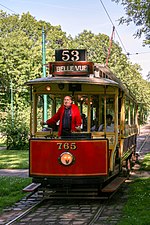Heaton Park Reservoir

Heaton Park Reservoir is a granite sided reservoir in the North-West of England, on the border between the City of Manchester and Bury and is owned by United Utilities, and can be found within the grounds of Heaton Park. Heaton Park BT Tower lies on the banks of the reservoir, which is close to Junction 18 of the M60 motorway.An aqueduct carrying water from Haweswater, in the Lake District, to Manchester terminates at Heaton Park Reservoir. The aqueduct was inaugurated in June 1955, is 82 miles (132 km) in length and carries up to 100 million imperial gallons (450,000 m3) of water per day under the force of gravity.In 2008, a £3.5 million Ultra-Violet (UV) disinfection plant was installed at Heaton Park water treatment works to meet water quality requirements. The UV building was designed to nestle within the embankment of the existing service reservoir.
Excerpt from the Wikipedia article Heaton Park Reservoir (License: CC BY-SA 3.0, Authors, Images).Heaton Park Reservoir
Bridle Road,
Geographical coordinates (GPS) Address Nearby Places Show on map
Geographical coordinates (GPS)
| Latitude | Longitude |
|---|---|
| N 53.540833333333 ° | E -2.2636111111111 ° |
Address
Bridle Road
Bridle Road
M25 2RN , Heaton Park
England, United Kingdom
Open on Google Maps







